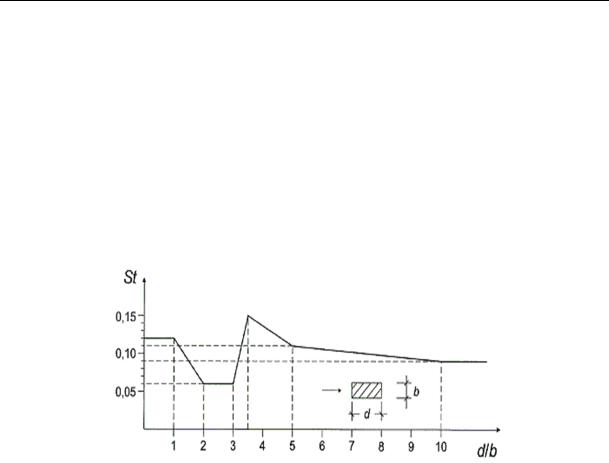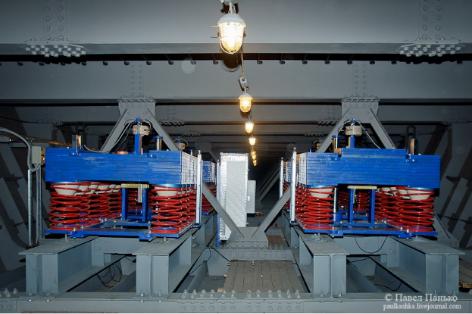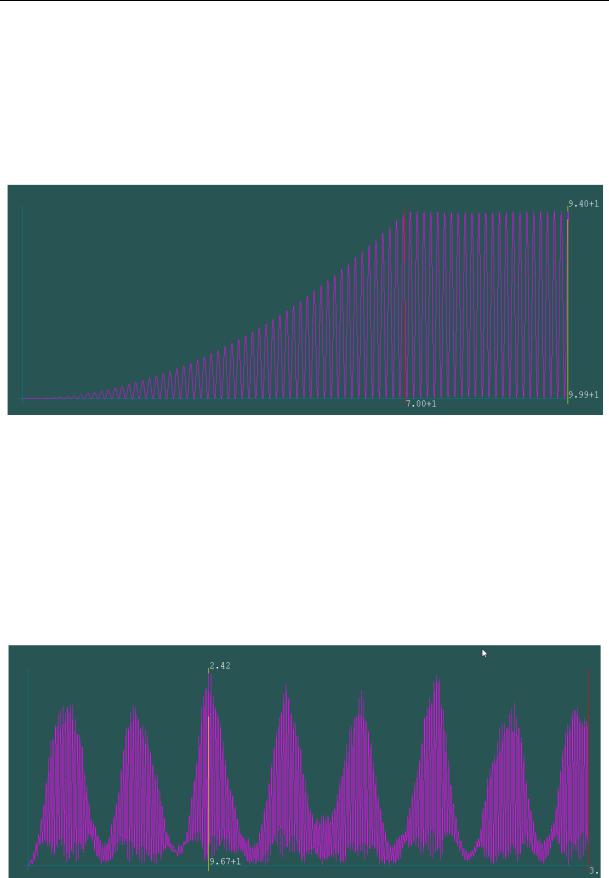
3833
.pdf
Russian Journal of Building Construction and Architecture
documents, there is already an addition: "Suspension and cable-stayed bridges, as well as steel beam bridges with spans of more than 100 m, should be checked for aerodynamic stability..." Thus, the oscillations of the Volgograd bridge were an ideal full-scale non-destructive experiment, according to the results of which the corresponding amendments were made to the normative and technical documentation. To identify the aerodynamic parameters of the span one can use Eurocode 4 [3]. The maximum height of the span (taking into account the transverse gradient and the bench) is b = 3.6 m; the width along the edges of orthotropic deck is d = 17.4 m; ratio d/b = 4.83; the Strouhal number St = 0.115 (Fig. 4); the aerodynamic coefficient based on the corresponding table [3] is Сlat = 1.1.
Fig. 4. Defining the Strouhal number based on Eurocode 4 [3]
2. Modeling the disturbing force of vortex stripping in the software package “Lira-
SAPR”. The calculations of oscillations of the Volgograd bridge are performed by the finite element method (FEM) in the licensed software package “Lira-SAPR”. The design scheme is made in the form of a continuous beam, composed of rod finite elements with the following stiffness characteristics (which were calculated based on the real structure of the span):
axial stiffness EF = 1.622·108 kN;
vertical bending stiffness EIy = 3.367·108 kN·m2;
horizontal bending stiffness EIz = 2.901·109 kN·m2;
torsional stiffness GIk = 1.855·108 kN·m2;
weight per meter (taking into account the bridge floor) q = 89.07 kN/m.
The periodic force of vortex stripping acts on the nodes of the design scheme of the span according to the harmonic law [9, p. 172]:
P 0.5 Vcr2Clatb l sin(vt). |
(3) |
Here the expression in square brackets is the amplitude of the intensity (distributed along the length of the span); l is the step of splitting the design model (the distance between the nodes
110

Issue № 4 (52), 2021 |
ISSN 2542-0526 |
of the span); ν is the vortex stripping resonance frequency (natural frequency of the span os-
cillations); t is the time.
3. Comparison of oscillations of a superstructure without dampers (resonance) and with
mass dampers. On the structure under consideration, after the occurrence of vibrations, the
following main measures were taken:
1)installation of mass dampers in the middle of the oscillating spans (Fig. 5), which excludes the possibility of resonance, since the frequency of natural oscillations of the dampers is selected in such a way as to most effectively knock down the oscillation frequency of the spans;
2)installation of fairings on the ends of the orthotropic plate, significantly weakening the effect of the wind flow on the structure under consideration.
Fig. 5. Mass dampers
Within this work, the simulation of free (without dampers) resonant oscillations of the Volgograd bridge, which occurred on May 20, 2010, was carried out, as well as the simulation of oscillations with installed dampers under a similar wind action (i.e., without taking into account the fairings). The performed calculation proved the effectiveness of the installed dampers and showed the possibility of performing preliminary analytical calculations of the aerodynamic stability of large-span bridges using one of the most widespread software systems in the Russian Federation and neighboring countries, “Lira-SAPR”. A simplified technique has been developed that can predict the possibility of similar situations and justify the need for detailed aerodynamic tests of large bridges.
111

Russian Journal of Building Construction and Architecture
Fig. 6 visually presents the phenomenon of resonance in the form of a graph of a smooth increase in the kinetic energy of the system (the calculation was performed in the "Dynamics Plus" module of the "Lira-SAPR" software package). Successively performed approximations showed that increasing the amplitude of oscillations up to 0.4 m (the value according to the conclusions of the expert commission) occurs when the duration of exposure to the harmonic force is 70 s. In this case, the kinetic energy of the flight reaches 94 MJ.
Fig. 6. The increase in kinetic energyin the absence of dampers (Integration time 100 s; integration step 0.01; number of shots 10000)
Fig. 7 presents the distribution of kinetic energy in case of installation in the middle of each three spans of mass dampers, spring-mounted charges 20 tons in weight. The stiffness of the springs was selected in such a way that the vibration energy was minimal. At the same time, the kinetic energy was reduced 40 times, from 94 MJ to 2.4 MJ. With the increase in the time of action of the perturbing force up to 300 s, the kinetic energy does not increase, and resonance does not arise.
Fig. 7. The distribution of kinetic energyafter installation of the dampers (Integration time 300 s; integration step 0.01; number of shots 30000)
112
Issue № 4 (52), 2021 |
ISSN 2542-0526 |
Calculation in the software package "Lira-SAPR" also makes it possible to evaluate the increment of efforts during oscillations with the given amplitude. In the most loaded sections of the Volgograd bridge with an amplitude of 0.4 m, the moment increased from 171185 to 221706 kN·m (+50521 kN·m). Since the limiting moment is 358065 kN m, the limiting state from the oscillations that occurred in 2010 did not arise.
Conclusions. For the preliminary aerodynamic calculation for wind resonance, the same initial data are required as for conventional static calculations (static scheme, stiffness characterristics, constant loads). Additionally, it is only required to reliably determine 2 aerodynamic characteristics: the Strouhal number St and the aerodynamic coefficient Clat. At the stage of pre-design studies, they can be determined theoretically using Eurocode 4 [3]. Then, with the positive result of the numerical aerodynamic calculation, one may make the physical model and test it in a wind tunnel. This will significantly reduce the labor intensity of real aerodynamic studies, since at the very design stage, the span structure solutions unstable to wind resonance will be excluded from consideration.
Referencesc
1.Ahmed N. U. and Harbi H. Stability of suspension bridge I: Aerodynamic and structural damping. Mathematical Problems in Engineering, 1998, vol. 4, iss. 1, pp. 73––98.
2.Cooper K. R., Mercker E. and Wiedeman J. Improved blockage corrections for bluff bodies in closed and open wind tunnels. Wind engineering into the 21st century, 1999.
3.EN 1994-2:2005 Eurocode 4: Design of composite steel and concrete structures. Part 2: General rules and rules for bridges.
4.Kazakevitch М. I. Aerodinamika mostov [Aerodynamics of bridges]. Transport, Мoscow, 1987.
5.Kozlov V. A. Stress and strain of multiply connected prismatic structures, mounted on a skewed crosssection. Scientific Herald of the Voronezh State University of Architecture and Civil Engineering. Construction and Architecture, 2016, no. 2 (30), pp. 17––23.
6.Kozlov V. A. The deflected mode of multi coherent prismatic constructive elements of bridge constructions.
Scientific Herald of the Voronezh State University of Architecture and Civil Engineering. Construction and Architecture, 2016, no. 3 (31), pp. 41––50.
7.Miyata T. Historical view of long-span bridge aerodynamics. Journal of Wind Engineering and Industrial Aerodynamics, 2003, vol. 91, pp. 1393––1410.
8.O’Connor C., ShawP. A. Bridgeloads. An international perspective. Taylor & Francis Group, 2000, 330p.
9.Petropavlovsky A. A., Kryltsov Е. I., Bogdanov N. N. and others, under the editorship of A. A. Petropavlovsky. Vantovye mosty[Cable-stayed bridges], Transport, Мoscow, 1985.
10.Safronov V. S., Antipov A. V. Experimental and computational analysis of resonant vibrations of a steelreinforced concrete spans of a highway bridge. Structural mechanics and structures, 2012, no. 2 (5), pp.52––59.
11.Salenko S. D., Gosteev Ju. A., Obukhovskiy A. D. Aerodynamic studies of typical multi-girder structures.
Thermal physics and aeromechanics, 2013, vol. 20, no 4, pp. 451––460.
12.Sato H. and Ogihara K. Aerodynamic characteristics of slotted box girders, Proceedings of the 28th Joint Meeting of the Panel on Wind and Seismic Effects, UJNR, 1996.
13.Scanlan R. H., Jones N. P. Aeroelastic analysis of cable-stayed bridges. Journal of Structural Engineering, 1990, vol. 116, no. 2, pp. 279––297.
14.Vezza M., Taylor I. Application of a discrete vortex method for the analysis of suspension bridge deck sections. Journal of Wind and Structure, 2001, vol. 4, pp. 333––335.
15.Vikas Arora. Hybrid Viscous-Structural Damping Identification Method. Vibration Engineering and Technology of Machinery, Mechanisms and Machine Science, 2015, vol. 23, pp. 209––218.
113

Russian Journal of Building Construction and Architecture
16.Wilson E. L. Spatial static and dynamic analysis of structures. Physical approach with a focus on earthquake engineering. Computers and structures, 2002, 423 p.
17.Xiaobing Liu, Zhengqing and Chenb Zhiwen Liu. Direct simulation method for flutter stability of bridge deck. The Seventh International Colloquium on Bluff Body Aerodynamics and Applications (BBAA7), China, 2-6 September 2012.
18.Yuh-Yi Lin, Chii-Ming Cheng, Jong-Cheng Wu, Tsang-Lien Lan and Kuo-Ting Wu. Effects of deck shape and oncoming turbulence on bridge aerodynamics. Tamkang Journal of Science and Engineering, 2005, vol. 8, no. 1, pp. 43––56.
19.Available at: www.skyscrapercity.com: Volgograd Bridge.
114

Issue № 4 (52), 2021 |
ISSN 2542-0526 |
CITY PLANNING,
PLANNING OF VILLAGE SETTLEMENTS
DOI 10.36622/VSTU.2021.52.4.011
UDC711.16:504.75
V. А. Ilyichev 1, V. I. Kolchunov 2, N. V. Bakaeva 3, A. A. Kormina 4
URBAN ENVIRONMENT DESIGN: NEW METHODOLOGICAL APPROACHES
BASED ON THE BIOSPHERE COMPATIBILITY PARADIGM (PART 2)
Russian Academy of Architecture and Construction Sciences (RAACS) 1
Moscow, Russia
Southwest State University, Russian Federation2
Kursk, Russia
Moscow State University of Civil Engineering 3, 4
Moscow, Russia
1Аcademician of RAACS, D. Sc. in Engineering, Prof., e-mail: ilyichev@raasn.ru
2Аcademician of RAACS, D. Sc. in Engineering, Prof., e-mail: asiorel@mail.ru
3Advisorof of RAACS, D. Sc. in Engineering, Prof., e-mail: natbak@mail.ru
4PhD student, e-mail: sascha-girl@mail.ru
Statement of the problem. New challenges of our time significantlyaffect the methodology of urban planning.Thedevelopment ofnewprinciplesofcitylife, regulatingthebiospherecompatibilityofcities andthedevelopment ofhuman capital, shouldbe consideredan urgent scientifictaskthatrequiresidentifyingthepatternsoffunctioningofurban elementsofplanningstructures(residentialareas).
Results. The paper develops the methodological foundations of urban planning, design and evaluation of design options for residential planning units of the city (quarter, neighborhood, residential area) on the principles of the paradigm of biosphere compatibilityof cities and settlements that develop people. A conceptual model of the functional and planning organization of the territorythe hierarchy of city functions – is proposed. An algorithm for evaluating variants of residential area planning projects based on the index of urban function provision has been developed. For each of the functions of the city, the necessaryand sufficient composition of indicators for evaluating design decisions is identified. The article discusses the prospect of quantifying the social wellbeing of the population of residential areas of a biosphere-compatible city as an alternative condition for the formation of a comfortable urban environment.
Conclusion. Thenumerical evaluation ofthe design solution and a comparative analysis ofthe level of favorability of a residential neighborhood using the principles of the biosphere compatibilityparadigm show what changes are required in the composition of urban planning solutions not onlytoachieve the qualityofthematerialenvironmentoflife, but alsohuman development in allrespects.
Keywords: territorial planning; urban planning; evaluation of design solutions; methodology; project planning of the territory; paradigm of biosphere compatibility of cities and human-made settlements; favorable and comfortable urban environment.
Introduction. The public need to organize a favorable urban environment calls for a revision of the design paradigm of modern urban planning towards the self-sustaining development of
© Ilyichev V. А., Kolchunov V. I., Bakaeva N. V., Kormina A. A., 2021
115

Russian Journal of Building Construction and Architecture
urbanized territories based on the unity of the settlement and the environment, consciousness and inseparability of humans from nature for the sake of achieving and maintaining the required standard of living for both current and future generations [15]. This calls for a new scientific approach to be developed which will provide urban development tools for physical, spiritual, social development [5]. From this perspective, it is obvious a special direction in urban planning science associated with the development of a fundamentally new methodology and principles for designing a comfortable and safe living environment is essential [10].
At present one of the effective tools for improving the quality of the urban environment and the transition of Russian cities to modern development models is the new article of the Civil Code of the Russian Federation introduced in December 2020 on the types of integrated development of territories1. According to it, it should be considered that the legislative initiative will assist city planners in ameliorating the efficiency of improvement, development and reconstruction of the urban environment and will lay the foundation for improving the regulatory framework in urban regulation and architectural design. There is thus a narrower, but no less urgent task of improving the methodology of territorial planning and design of residential formations as the key element of the planning structure of the city [1]. These are residential areas that are central to the qualitative characteristics of the urban environment [12, 13].
The objective of the article is to develop the methodological foundations of urban planning, design and assessment of options for design solutions for residential planning units of the city (quarter, microdistrict, residential area) as part of territorial planning projects with the functions of a biosphere-compatible city.
1. Methodology and methods. Thetheoretical foundationofthe study is a new paradigmoflife, i.e., biosphere-compatible cities and human-made settlements developed in the RAASN [6]. The sequence ofparadigm principles establishes the priorities and hierarchy of fundamental concepts of life, identifies problem areas in the organization of city life, enable one to calculate the level of symbiotic relations between the city and nature and quantify the opportunities offered by the city for the development its residents. The algorithm for the sequential implementation of the provisions of the paradigm of biosphere compatibility is described in detail in the first part of the paper and includes the following assessment blocks: environmental safety, resources of spatial and territorial support and structural and planning organization of a residential area/microdistrict [9].
1 Civil Code of the Russian Federation Article 65. Types of complex development of the territory (introduced by the Federal Law of 30.12.2020 N 494-FZ).
116
Issue № 4 (52), 2021 |
ISSN 2542-0526 |
One of the principles of the paradigm of biosphere compatibility is the principle governing the design of a favorable living environment with the urban functions and the formation of infrastructural conditions for the comprehensive human development.
2. Proposals for developing the methodology of urban planning and design of residential
formations of the city. The development of the design methodology of urban planning solutions involves application of the hierarchy of city functions –– life support, entertainment and emotions, power, mercy, knowledge acquisition, knowledge of the world (creativity), connection with nature –– as a conceptual model of the functional planning organization of a residential area [14]. This model enables us to consider the hierarchy of the above city functions as an analogy of the geometric projection of human needs on the planning and design solutions of residential areas of the city [11]. In this case, during territorial planning using the functional approach and the suggested model, justification of the compliance of the planned parameters, location and aim of objects with the standards of urban planning and the requirements of urban planning regulations established by the calculated indicators of the minimum permissible level of facilities of communal, transport, social infrastructures in the area and the calculated indicators the maximum permissible level of their accessibility by the population. According to the paradigm of a biosphere-compatible city, all of its functions are the major ones [8]. They can be implemented in compliance with the scheme of territorial levels of the planning structure of residential areas: built-up or reconstructed territory of a residential building, quarter, microdistrict, district and the entire city. Therefore in relation to the territory of a residential quarter, all the above city functions are planned in a minimum volume within walking distance. The implementation of all functions for the next level –– a residential microdistrict –– is ensured during the development of a territory planning project, design of residential buildings, courtyards of territorial infrastructure facilities and recreational spaces. At this level, the components of the district level are added to the structure of the functional planning organization. E.g., if the implementation of the «Connection with Nature» function at the level of a project of a specific residential building is ensured by landscaping the courtyard, at the microdistrict level it provides a wide range of recreational infrastructure for residents of the entire microdistrict –– green recreational spaces (squares and other recreation areas) [7]. A similar example can be provided in relation to the «Life Support» function for the “Institutions, Organizations and Service Enterprises” component: at the microdistrict level, these facilities are not limited to stores with essential goods, but the construction of multidisciplinary shopping centers is being planned with further reconstruction in mind [3].
117

Russian Journal of Building Construction and Architecture
It should be particularly noted that in order for a living environment to be called not only a favorable, but also a comfortable one, urban infrastructure facilities in residential areas should be implemented for each resident individually tailored to their interests and physical capabilities, and for all residents at the same time with public interest in mind. In this case, while designing and assessing the structural, planning and architectural organization of a residential area/microdistrict, a special role is played by the formation of a socially significant infrastructure [4, 18], practical implementation oftheprinciple ofsocialplanning [22] and priorityofsocial values ofthepopulation[20], equality, opportunities[17], socialhealth[23], participation in urbanplanning [19].
3. Assessment of residential areas with urban functions. The design method adopted in Russian urban planning practice predetermines the assessment procedures for the conditions of the urban environment that contribute to human development. A quantitative assessment of the quality of a residential area planning project is a process where the ability of an object to perform the functions prescribed by the designer, ensuring favorable conditions for residents is revealed. In this study, the methodology for assessing options and choosing a rational design solution in planning projects for the territory of residential formations relies on a system of integral indicators [2] obtained from the values of individual currently standardized parameters of the urban environment identified by statistical and expert methods.
The hierarchy of city functions is a conceptual model of the variant design assessment methodology. Using estimated indicators of the feasibility of city functions within the framework of qualimetry methods it is possible to assess the scale of order (ranks) which will allow one to rank residential areas (microdistricts/quarters), i.e. to arrange them in ascending order of quantitative assessment of their quality. For these purposes, a comprehensive indicator is set forth - the index of assessing the provision of urban functions which can be calculated based on a a variety of indicators characterizing the compliance of the infrastructure of a residential area necessary for the implementation ofall seven functions of the city, with regulatory requirements.
Let usconsider the justificationoftheestimated indicatorsfor thecityfunctions in moredetail. The function «Life Support» is to be assessed in terms of material (physical) comfort and safe living conditions. This function is formed by a number of characteristics and normative parameters of the projected residential development of the district/microdistrict:
the structure of the housing stock2; energy efficiency class; insolation, the level of greening of residential yards and others;
2 SP 54.13330.2016 “Residential Apartment Buildings. Updated Edition of SNiP 31-01-2003".
118

Issue № 4 (52), 2021 |
ISSN 2542-0526 |
road network3;
engineering equipment and engineering protection of the territory;
integrated security.
The estimated indicators are primarily formed according to the standards of urban planning SP (СП) 42.13330.2016 2016 «Urban Planning. Planning and Development of Urban and Rural Settlements. Updated Edition of SNiP (СНИП) 2.07.01-89*» based on which the construction of service sector facilities (trade, public catering, household production and housing and communal services, mini-production, healthcare, etc.), transport infrastructure and their availability in accordance with the population of the residential area/microdistrict. Among the objects of service, it is suggested in the design not all of their nomenclature presented are considered by the joint venture but related to the system of primary/daily maintenance and life support. These days institutions and public service enterprises in a modern city form a single system covering residential areas and places of employment. The current urban planning trend and architectural practice is designed to combine service facilities and living quarters into community centers located on the lower floors of residential buildings.
An important factor in the composition of the life-supporting function is the improvement of the territory4, which is currently part of the program activities of the national and federal projects «Housing and Urban Environment» and «Formation of a Comfortable Urban Environment». In connection with the priority direction of urban planning activities in the field of improvement of the territory of residential areas, it is suggested that the list of estimated indicators is supplemented with the indicators that are important for analyzing the quality of the modern urban environment such as:
proportion of playgrounds in the total area of the design site (%);
proportion of sites for adults and the elderly in the total area of the design site (%);
proportion of outdoor sports grounds in the total area of the design site (%);
proportion of dog walking areas in the total area of the design site (%);
proportion of parking lots per apartment.
The «Entertainment and Leisure» function at the city level is implemented by objects that are part of cultural and art institutions (cinemas, museums, etc.), objects that are part of the group of catering enterprises (cafes, restaurants) as well as physical culture and sporting institutions. Depending on the level of the element of the planning structure of a residential area, the im-
3SP 396.1325800.2018 “Streets and Roads of Settlements. Urban Planning Rules".
4SP 82.13330.2016 Land Improvement. Updated edition of SNiP III-10-75.
119
